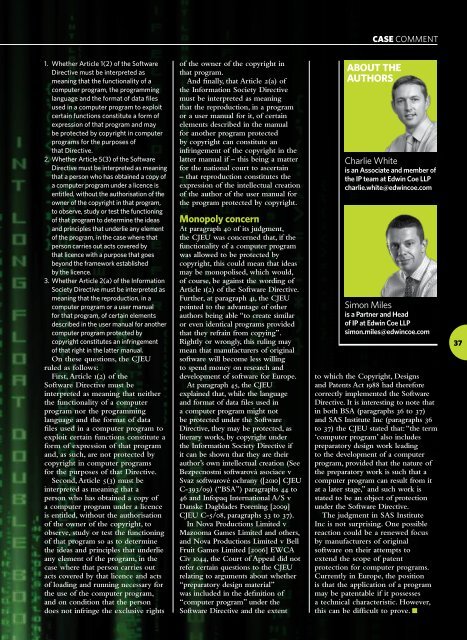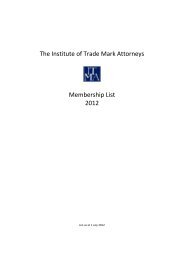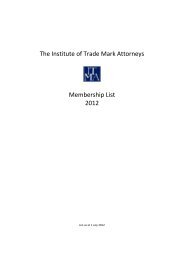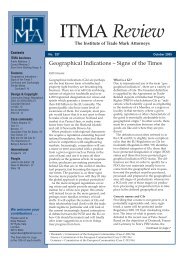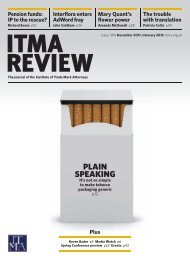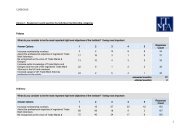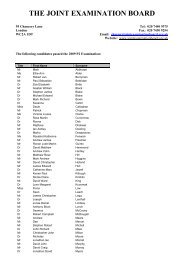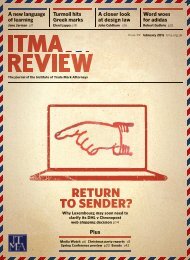accountant .agency.amazon .baby .beer .business.caravan .chanel ...
accountant .agency.amazon .baby .beer .business.caravan .chanel ...
accountant .agency.amazon .baby .beer .business.caravan .chanel ...
Create successful ePaper yourself
Turn your PDF publications into a flip-book with our unique Google optimized e-Paper software.
1. Whether Article 1(2) of the Software<br />
Directive must be interpreted as<br />
meaning that the functionality of a<br />
computer program, the programming<br />
language and the format of data files<br />
used in a computer program to exploit<br />
certain functions constitute a form of<br />
expression of that program and may<br />
be protected by copyright in computer<br />
programs for the purposes of<br />
that Directive.<br />
2. Whether Article 5(3) of the Software<br />
Directive must be interpreted as meaning<br />
that a person who has obtained a copy of<br />
a computer program under a licence is<br />
entitled, without the authorisation of the<br />
owner of the copyright in that program,<br />
to observe, study or test the functioning<br />
of that program to determine the ideas<br />
and principles that underlie any element<br />
of the program, in the case where that<br />
person carries out acts covered by<br />
that licence with a purpose that goes<br />
beyond the framework established<br />
by the licence.<br />
3. Whether Article 2(a) of the Information<br />
Society Directive must be interpreted as<br />
meaning that the reproduction, in a<br />
computer program or a user manual<br />
for that program, of certain elements<br />
described in the user manual for another<br />
computer program protected by<br />
copyright constitutes an infringement<br />
of that right in the latter manual.<br />
On these questions, the CJEU<br />
ruled as follows:<br />
First, Article ı(2) of the<br />
Software Directive must be<br />
interpreted as meaning that neither<br />
the functionality of a computer<br />
program nor the programming<br />
language and the format of data<br />
files used in a computer program to<br />
exploit certain functions constitute a<br />
form of expression of that program<br />
and, as such, are not protected by<br />
copyright in computer programs<br />
for the purposes of that Directive.<br />
Second, Article 5(3) must be<br />
interpreted as meaning that a<br />
person who has obtained a copy of<br />
a computer program under a licence<br />
is entitled, without the authorisation<br />
of the owner of the copyright, to<br />
observe, study or test the functioning<br />
of that program so as to determine<br />
the ideas and principles that underlie<br />
any element of the program, in the<br />
case where that person carries out<br />
acts covered by that licence and acts<br />
of loading and running necessary for<br />
the use of the computer program,<br />
and on condition that the person<br />
does not infringe the exclusive rights<br />
of the owner of the copyright in<br />
that program.<br />
And finally, that Article 2(a) of<br />
the Information Society Directive<br />
must be interpreted as meaning<br />
that the reproduction, in a program<br />
or a user manual for it, of certain<br />
elements described in the manual<br />
for another program protected<br />
by copyright can constitute an<br />
infringement of the copyright in the<br />
latter manual if – this being a matter<br />
for the national court to ascertain<br />
– that reproduction constitutes the<br />
expression of the intellectual creation<br />
of the author of the user manual for<br />
the program protected by copyright.<br />
Monopoly concern<br />
At paragraph 40 of its judgment,<br />
the CJEU was concerned that, if the<br />
functionality of a computer program<br />
was allowed to be protected by<br />
copyright, this could mean that ideas<br />
may be monopolised, which would,<br />
of course, be against the wording of<br />
Article ı(2) of the Software Directive.<br />
Further, at paragraph 4ı, the CJEU<br />
pointed to the advantage of other<br />
authors being able “to create similar<br />
or even identical programs provided<br />
that they refrain from copying”.<br />
Rightly or wrongly, this ruling may<br />
mean that manufacturers of original<br />
software will become less willing<br />
to spend money on research and<br />
development of software for Europe.<br />
At paragraph 45, the CJEU<br />
explained that, while the language<br />
and format of data files used in<br />
a computer program might not<br />
be protected under the Software<br />
Directive, they may be protected, as<br />
literary works, by copyright under<br />
the Information Society Directive if<br />
it can be shown that they are their<br />
author’s own intellectual creation (See<br />
Bezpecnostní softwarová asociace v<br />
Svaz softwarové ochrany ([20ı0] CJEU<br />
C-393/09) (“BSA”) paragraphs 44 to<br />
46 and Infopaq International A/S v<br />
Danske Dagblades Forening [2009]<br />
CJEU C-5/08, paragraphs 33 to 37).<br />
In Nova Productions Limited v<br />
Mazooma Games Limited and others,<br />
and Nova Productions Limited v Bell<br />
Fruit Games Limited [2006] EWCA<br />
Civ ı044, the Court of Appeal did not<br />
refer certain questions to the CJEU<br />
relating to arguments about whether<br />
“preparatory design material”<br />
was included in the definition of<br />
“computer program” under the<br />
Software Directive and the extent<br />
CASE COmmeNt<br />
ABOUT THE<br />
AUTHORS<br />
Charlie White<br />
is an Associate and member of<br />
the IP team at Edwin Coe LLP<br />
charlie.white@edwincoe.com<br />
Simon miles<br />
is a Partner and Head<br />
of IP at Edwin Coe LLP<br />
simon.miles@edwincoe.com<br />
to which the Copyright, Designs<br />
and Patents Act ı988 had therefore<br />
correctly implemented the Software<br />
Directive. It is interesting to note that<br />
in both BSA (paragraphs 36 to 37)<br />
and SAS Institute Inc (paragraphs 36<br />
to 37) the CJEU stated that: “the term<br />
‘computer program’ also includes<br />
preparatory design work leading<br />
to the development of a computer<br />
program, provided that the nature of<br />
the preparatory work is such that a<br />
computer program can result from it<br />
at a later stage,” and such work is<br />
stated to be an object of protection<br />
under the Software Directive.<br />
The judgment in SAS Institute<br />
Inc is not surprising. One possible<br />
reaction could be a renewed focus<br />
by manufacturers of original<br />
software on their attempts to<br />
extend the scope of patent<br />
protection for computer programs.<br />
Currently in Europe, the position<br />
is that the application of a program<br />
may be patentable if it possesses<br />
a technical characteristic. However,<br />
this can be difficult to prove.<br />
37


